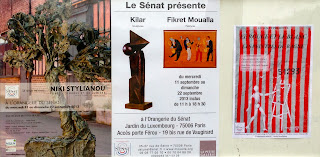AN UNFORESEEABLE MIXTURE OF ODDITIES
A strange week full of oddities which I would normally not go to see. The first was in the Orangerie in the Luxembourg Gardens. Just on for a couple of days and as usual, I had time before going to a conference. Three artists. Niki Stylianou «Forest - Shadows and Light». Kilar with wooden sculptures and Fikret Moualla, paintings. The document outside the museum didn’t say much more than that.

I liked Niki’s work. His father was Greek, his mother Russian and he lives in Paris. Not bad going. I would think that he had a real fascination for trees. He worked with wax which led him into a new area. Trees and each tree with its movement led him to another. Each sculpture had a different movement and his sculptures were reflected in his paintings. If you could define them as such.
I’m afraid that I have nothing to tell you about Kilar and not much about Fikret Moualla, although there is a lot on Internet.
Next moment without really planning it, I was at the Louvre. It always impresses me when I see sculptures which were created thousands of years BC.
And even when we crossed the Gallery with La Jaconde, the crowds were far less that usual and I guess with a little patience she could be photographed.
Today Gianni and I were off to the Gagosian Gallery to see «Lichtenstein : Expressionism» A very different presentation from what I had seen at the Beaubourg (see 10th August Lichtenstein ) Here it is quite obvious that he had studied the work of Picasso, Miro or Klee. He incorporated different colours and different shapes which we know so well. However, his version of «Déjeuner sur l’Herbe» - Monet, was very surprising and beautifully displayed.
We hadn’t be able to get to the Braque as it was closed on Mondays. So off to the Jacquemart-André to see «Désir et Volupté» Victorian Masterpices.
Am glad that London is calling. Two marvelous exhibitions coming up which I have been looking forward to for months.

I liked Niki’s work. His father was Greek, his mother Russian and he lives in Paris. Not bad going. I would think that he had a real fascination for trees. He worked with wax which led him into a new area. Trees and each tree with its movement led him to another. Each sculpture had a different movement and his sculptures were reflected in his paintings. If you could define them as such.
 |
 |
 |
 |
 |
 |
 |
 |
I’m afraid that I have nothing to tell you about Kilar and not much about Fikret Moualla, although there is a lot on Internet.
 |
| Kilar's scculpture |
Fikret Moualla belongs to the generation of colour masters which appeared by the advent of German Expressionism and fauvism, in the late 19th and the early 20th century.When I read this, I understood why so much of his work was for me «déjà vu». Of course it’s pleasant but I wont be shouting about it.
In spite of the lieu of the subjects of his paintings which are typically "parisien", one can see an eventual omission of perspective to increase the content, a feeling of isolation of the personnages, non-crossing regards; a clear relation between his style and Ottoman miniatures.
 |
 |
 |
 |
| The Pyramid |
Next moment without really planning it, I was at the Louvre. It always impresses me when I see sculptures which were created thousands of years BC.
 |
| 1400-1300BC |
 |
| Male figure 5000-3500BC |
 |
| Human Form - Neolithic |
 |
| The head of human form |
 |
| Iron age |
 |
| Column - Darias Palace - 510 BC |
 |
And even when we crossed the Gallery with La Jaconde, the crowds were far less that usual and I guess with a little patience she could be photographed.
Today Gianni and I were off to the Gagosian Gallery to see «Lichtenstein : Expressionism» A very different presentation from what I had seen at the Beaubourg (see 10th August Lichtenstein ) Here it is quite obvious that he had studied the work of Picasso, Miro or Klee. He incorporated different colours and different shapes which we know so well. However, his version of «Déjeuner sur l’Herbe» - Monet, was very surprising and beautifully displayed.
 |
| Seeing it from far off |
 |
| His déjeuner..... |
 |
 |
From the Pérez Simón CollectionI didn’t know any of the artists and to be quite honest, this is not an exhibition I would have chosen to see myself. Frankly I find this period rather kitsch and overly realistic. The women are just too perfect.
The exhibition invites you to discover the artists famous in England during the reign of Queen Victoria in the 19th century, including Sir Lawrence Alma-Tadema (1836-1912), Sir Frederic Leighton (1830-1896), Edward Burne-Jones (1833-1898) and Albert Moore (1841-1893). The fifty or so paintings exhibited reflect the common desire of the artists of this period to pay homage to the “cult of beauty”
 |
| Andromède E.J.Poynter |
 |
| Frederic Leighton |
 |
| Frederic Leighton |
 |
| Queen Esther - E. Long |
 |
| Am not sure but I liked her.... |
 |
| Roses of Heliogabale - Alma Tadema |
Am glad that London is calling. Two marvelous exhibitions coming up which I have been looking forward to for months.





Commentaires